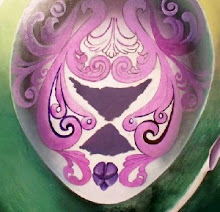The question of using photographic references only affects those artists who create imagery that (to at least some degree) resembles something else. So, the following essay may not apply to artists who are relatively unconcerned with any sort of visual verisimilitude...
In several of the on-line art discussion forums in which I hang out, artists frequently question the validity of using photographs as the basis for drawings, paintings, digital imagery, and other types of art.
Some artists argue that there's nothing "wrong" with copying, tracing--with more-or-less duplicating--any photographic reference image from any source. (Of course there are copyright concerns when using photographs other than your own, but I think there are significant aesthetic reasons why virtually copying a photographic image--even if you were the photographer and thus own the copyright--isn't a very "good" idea.)
Other artists argue that one should only ever work from actual people and objects; that visual artists should never use photographic refrences, "period".
I'm going to try to argue for a more philosophical approach to the question of photographic references; as I find the opinions at either extreme, rather limiting.
First, there are several reasons why photographic references are a very useful tool for visual artists. There is certainly no question that visual artists have been facinated by photographic imagery since the birth of photography (which can be dated to either 1827 or 1839, depending on whether you consider the first photographs to be the eight-hours-plus exposures produced by Niepce, or the later slightly-longer-than-one-hour exposures created using Daguerre's process more than a decade later).
The early photographic experiments of Edward Muybridge (1830-1904), which captured the intricacies of animal and human movement in strobe-lit stop-motion sequences, are only one example of how photography is able to reveal subtle information that the human eye cannot easily perceive (or may not be able to perceive at all) For example, Muybridge's photographs revealed for the first time, that all four of a horses hooves leave the ground during a gallop. Numerous early works of equestrian art were thus revealed as "flawed".)
Second, even artists who aren't interested in extremely-short, or extremely-long-duration events, can benefit from photographic references. Portrait artists (and/or figurative artists in general) understand that figure models cannot hold certain poses for more than a moment or two. (Other poses are too difficult to be held for more than a few seconds.) "Action poses"--such as running, turning, or jumping--cannot even be "held" at all. Photography makes it possible to see the details of human and animal bodies-in-motion that were virtually invisible before 1872.
Third, using photographs is far easier than arranging a photo-shoot every time an artist decides to create a drawing, painting, or sculpture. Photographic reference images are available in books, magazines, newspapers--and even more readily available on-line.
Of course there are numerous advantages to working from actual objects, or people, rather than relying on photographs . Photographs are two-dimensional, and reveal an object or scene from a single viewpoint. Human beings, though, have stereo vision; we see objects far differently than cameras do. The edges of rounded objects often appear fuzzy, because both eyes can't focus on the same point along the curved edge. In photos, however, edges often appear perfectly sharp, and it's difficult for artists who only work from photos to learn to compensate for the differences between the way cameras "see", and the way human vision actually works.
For artists creating portraits, still life imagery, product illustrations, etc, it's best to work "from life"--from the actual object in the actual environment being depicted, again because "reality" provides far more information, as well as direct ineraction, with the subject, than a photograph (or photographs) can.
(I know I rarely see a photograph that "looks like me"; a portraitist working from a photograph of me, is at a definite disadvantage, before the painting even starts!)
Of cousrse, working from actual objects and/or living models isn't always possible. An artist might be asked to create a portrait of a person who is no longer among the living, in which case the artist would have no choice but to rely on photographic references, taken while the person was alive. Further, imaginary objects and scenes can't be photographed unless they are first made real; built or constructed somehow. Its much easier to draw or paint something than to actually create it (and much less expensive to work from photographs of the Sphynx, than arrange a trip to Egypt!)
While all of the above seems quite sensible to me, none of it touches on what I believe to be the best reasons why I believe simply copying from reality--whether directly, or from photographs--is far too limiting.
For me, the key is imagination...
To be continued.
10 May 2010
Subscribe to:
Post Comments (Atom)

No comments:
Post a Comment